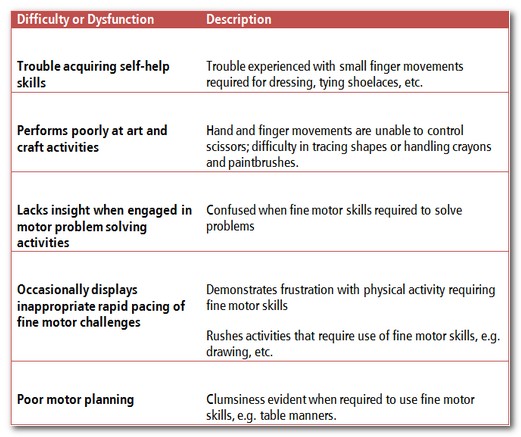| Fine motor skills | Hand movements |
| Fine motor problems |
Fine motor skills
Fine motor skills are movements mainly produced by the body's small muscle groups. These muscle movements are used in tasks such as:
- writing
- drawing
- playing musical instruments
- tying knots
- using a computer keyboard.
Fine motor skills generally involve the co-ordination of the hands and eyes though there are exceptions. This is called sensory integration, i.e. integrating the use of the senses to achieve a goal.
| Frequently Asked Questions about Fine Motor Skills |
The general fine motor difficulties experienced within school settings are summarised below:

Generally within learners the proximodistal rule of motor development is followed.
This means that development is staged from the centre of the body (i.e. the torso, shoulders, etc.) progressively to the extreme points (i.e. fingers).
When discussing fine motor skills the most observed area if the use of a person's hands. The use of the hands and its parts (i.e. the fingers, thumb and palm) is generally categorised by three types of movement:
Simple synergies
These movements involve similar actions of all fingers and the thumb. Such actions include:
- squeezing a rubber ball
- pinching and squeezing
Reciprocal syngeries
This refers to the interaction of the fingers and thumb to produce dissimilar (i.e. different) movements. Such actions include:
- twiddling the thumb
- rolling a pencil between the thumb and forefinger
Sequential patterns
These movements describe sequential rather than simultaneous hand movements. Simultaneous movements are either reciprocal or simple synergies, where as sequential patterns are a series of movements in sequence (i.e. one after another). Such actions include:
- tying a knot
- doing up a shirt
Drawing and handwriting
Stages of drawing
Generally learners draw before they attempt to write. This is the initial stage used to make them familiar with writing tools and refine their fine motor skills.
Generally there are four stages in the drawing phase:
- Scribbling
- Combining
- Aggregate
- Pictorial
While a person's progression through these stages is sequential the age at which a person may enter the stages is influenced by home environment, range of disabilities and developmental readiness.
Stages of writing
Like drawings, the products of handwriting also occur in sequential stages. The list below is a general indication of a young learner is capable of:
4 years of age |
Children can usually write recognisable letters, although they are often scattered randomly over the page. |
5-6 years of age |
Children can usually print their names in large (1.5 - 5 cm) upper case. |
7 years of age |
Children's writing is usually smaller (about 0.5 cm) and printed effectively in lower case. |
| What letters are difficult to write? | |
| How does fine motor skill development affect handwriting? |
Activities for fine motor skills
|
Activity 3.3 Make a list of fine motor activities you could do with the following groups of students: In a paragraph write which groups were easier to think of activities for? Why? Email your response as an attachment to your trainer. |